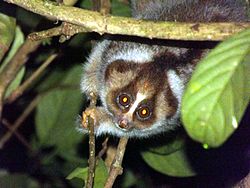Portal:Primates
The Primates Portal A primate is a member of the biological order Primates, the group that contains lemurs, the aye-aye, lorisids, galagos, tarsiers, monkeys, and apes, with the last category including great apes. With the exception of humans, who inhabit every continent on Earth, most primates live in tropical or subtropical regions of the Americas, Africa and Asia. Primates range in size from the 30-gram (1 oz) pygmy mouse lemur to the 200-kilogram (440 lb) mountain gorilla. According to fossil evidence, the primitive ancestors of primates may have existed in the late Cretaceous period around 65 mya (million years ago), and the oldest known primate is the Late Paleocene Plesiadapis, c. 55–58 mya. Molecular clock studies suggest that the primate branch may be even older, originating in the mid-Cretaceous period around 85 mya. Primates exhibit a wide range of characteristics. Some primates do not live primarily in trees, but all species possess adaptations for climbing trees. Locomotion techniques used include leaping from tree to tree, walking on two or four limbs, knuckle-walking, and swinging between branches of trees (known as brachiation). Primates are characterized by their large brains relative to other mammals. These features are most significant in monkeys and apes, and noticeably less so in lorises and lemurs. Many species are sexually dimorphic, which means males and females have different physical traits, including body mass, canine tooth size, and coloration.
Selected article
Mesopropithecus is an extinct genus of small to medium-sized lemur, or strepsirrhine primate, from Madagascar that includes three species, M. dolichobrachion, M. globiceps, and M. pithecoides. Together with Palaeopropithecus, Archaeoindris, and Babakotia, it is part of the sloth lemur family (Palaeopropithecidae). As it had the shortest forelimbs of all sloth lemurs, it is thought that Mesopropithecus was more quadrupedal and did not use suspension as much as the other sloth lemurs. They are known only from subfossil remains and died out after the arrival of humans on the island, probably due to hunting pressure and habitat destruction. Mesopropithecus was one of the smallest of the extinct subfossil lemurs, but was still slightly larger than the largest living lemurs. Although rare, the three species were widely distributed across the island yet allopatric to each other, with M. dolichobrachion in the north, M. pithecoides in the south and west, and M. globiceps in the center of the island. All three species were primarily a leaf-eaters (folivores), but also ate fruit and seeds.
Selected picture A Barbary macaque (Macaca sylvanus) by the Upper Rock Nature Reserve in Gibraltar. Although the species is commonly referred to as the "Barbary ape", it is in fact a monkey. The Barbary macaque population in Gibraltar is the last in the whole of the European continent. A popular belief holds that as long as Barbary macaques exist on Gibraltar, the territory will remain under British rule. CategoriesSelected speciesNot evaluated (IUCN 3.1)|
Nycticebus kayan is a strepsirrhine primate and a species of slow loris that is native to the northern and central highland region of the island of Borneo. The species was originally thought to be a part of the Bornean slow loris (N. menagensis) population until 2013, when a study of museum specimens and photographs identified distinct facial markings, which helped to differentiate it. It is distinguished by the high contrast of its black and white facial features, as well as the shape and width of the stripes of its facial markings. The species is named after the Kayan River, which runs through its native habitat. As with other slow lorises, this arboreal and nocturnal species primarily eats insects, tree gum, nectar, and fruit and has a toxic bite, a unique feature among primates. Although not yet evaluated by the International Union for Conservation of Nature (IUCN), it is likely to be listed as "Vulnerable" or placed in a higher-risk category when its conservation status is assessed. It is primarily threatened by habitat loss and the illegal wildlife trade. Did you know?
Primate lists
WikiProjectsThings to do
Associated WikimediaDiscover Wikipedia using portals |

















